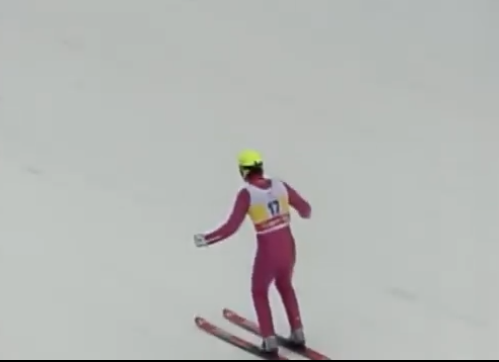The Olympic Winter Games in Nagano, Japan. The year - 1998.
1998年日本长野冬运会
Japan's best hope for a gold medal lay in the ski jump, and the man to carry that burden was 23-year-old Kazuyoshi Funaki.
日本最有希望在跳台滑雪上获得一枚金牌 能够担此重任的人 是23岁的船木一良
It takes years of preparation to reach the final of an Olympic ski jump event.
他准备了很多年 就是为了参加最终的奥运跳台滑雪
For decades, ski jumpers had been exploring the most effective way to fly through the air.
几十年里 跳台滑雪运动员们一直在探索最有效的方式
Funaki thought he had the answer to that question. So what was his secret?
船木一良认为自己已经找到了问题的答案 那他的秘诀是什么呢?
To answer that question, we need to take a look at the fascinating history of this event.
要回答这一问题 我们需要来看一下这件有趣的历史事件
Ski jumping was the most popular spectator sport at the 1952 Winter Olympic Games in Oslo, Norway.
在1952年挪威的奥斯陆冬奥会上 跳台滑雪是最受欢迎的观赏性体育项目
A crowd of 143,000 people, half the entire population of Oslo, turned up to see local hero Arnfinn Bergmann win gold for Norway.
当时有143000人 奥斯陆人口的一半 出席观看了本国英雄伯格曼为挪威赢得金牌的比赛
Ski jumping is Norway's gift to the world.
跳台滑雪是挪威奉送给世界的礼物

The sport was first introduced by a Norwegian soldier called Olaf Rye.
这项运动第一次是被一位名叫奥拉夫·黑麦的挪威士兵引进的
His party trick was jumping 9.5 metres on skis.
他在派对上常玩的戏法是踩着滑雪板从9.5米的高空跳下
That was in 1809. My hat. Oh. In 1952, the sport had moved forward.
那是在1809年 我的帽子 哦 这项运动在1952年已经得到了发展
Bergmann's winning jump reached 68 metres long.
伯格曼获胜的一跳达到了68米
Bergmann makes his winning jump, to give Norway her seventh gold medal in the Games.
伯格曼做出了成功的一跳把她在奥运会的第七枚金牌奉献给了挪威
Strength and technique had taken the sport to another level.
她的力量和技巧已经将这项运动带到了另一个等级上
All you have to do is slide, glide and stay on your feet if you can.
你所需要做的就是滑动、滑翔和尽可能地保持站立
In the '60s, subtle changes were made to the jumping style.
到了60年代 跳跃风格发生了微妙的变化
The body straighter, arms by the side.
身体更加直立 双手放在身体侧面
This was considered the correct and proper way to ski jump.
这被认为是跳台滑雪正确合适的方式
A great stylist of the '70s was Yukio Kasaya, the star of the 1972 Olympic Games in Sapporo.
70年代最伟大的设计师是雪雄笠屋 他是1972年札幌奥运会的明星
Kasaya was the first Japanese to win Olympic gold.
笠屋是第一个获得奥运会金牌的日本人
Style is important in ski jumping because your final score is a mix of distance plus style points.
风格在跳台滑雪中很重要 因为你最终的得分 是综合距离和风格得分
Five judges award marks out of 20. They are looking for elegance and smoothness, and a textbook "Telemark" landing.
5位裁判以20分为总分进行打分 他们会观察动作的优雅和流畅度 以及标准的“弓步”落地
A great jump is typically matched with excellent style, but actual perfection was unheard of.
一个完美的跳跃与优秀的风格有很大的关系 但是真正的完美是不存在的
Judges always found fault - that's what they're there for.
裁判总会寻找一些瑕疵 这也是他们存在的意义
Perhaps the most elegant and successful ski jumper in history was Finland's Matti Nykanen, the first ski jumper to win three gold medals in a single Olympic Games.
或许历史上最优雅和最成功的跳台滑雪运动员是芬兰的尼凯宁 她是第一位在一场奥运会上获得了三枚金牌的跳台滑雪运动员
Nykanen lifted the sport to an art form. No-one could get close to him.
尼凯宁将这一运动提升到了艺术水平 无人能及
His best jump at Calgary 1988 was nearly eight metres further than anyone else.
他最好的一跳是在1998年的卡尔加里 大约是8米多 超过了所有运动员
One who tried to get close was Czech Jiri Malec.
有一位尽力向尼凯宁靠近的运动员是捷克的吉瑞·马莱克
Malec believed that spreading his skis into a "V"shape, as you can see here, helped him achieve that little bit of extra distance.
马莱克认为将其滑雪板伸展成“V”形 正如你所看到的 可以帮助他获得更远的距离
Not enough to catch Nykanen, the perfect exponent of the parallel technique, but enough to help Malec win an Olympic bronze medal.
但还是赶不上尼凯宁 完美的平行技巧 足以帮助马莱克获得奥运会铜牌
Unfortunately, Malec's success was limited because judges preferred the clean lines of the classical ski jumpers and the new V technique was consistently marked down.
不幸的是 因为裁判们更喜欢传统跳台滑雪运动员干净的线条 这种新的“V”形技巧自始至终都被打低分 马莱克的成功受到了限制
And then it got scientific - a group of Japanese academics studied the physics behind the ski jumping technique.
此后 该运动变得更加系统 来自日本学术界的一个团队 研究了跳台滑雪技巧背后的物理规律
They crunched the numbers. They worked out the formulas.
他们通过数字处理 计算出了公式
Calculus, geometry, trigonometry, and the result was clear - the V shape was the way to go.
综合微积分 几何学和三角学 结果表明 “V”形才是正确的方式
Ski jumpers could barely switch quickly enough.
运动员们几乎跟不上这一快速转变
By 1992 it was the only way to fly and the judges had no choice but to adopt the new shape as the ideal ski jumping technique.
到了1992年 这成了空中飞行唯一的方式 裁判没有选择的余地只能将这种新的形式作为理想的跳台滑雪技巧
The 1998 Winter Olympics in Nagano, Japan, took the V technique to a new level.
1998年的日本长野冬奥会 将“V”技巧发展到了一个新的标准
The big Japanese favourite was Kazuyoshi Funaki, coached and mentored by the legendary Kasaya.
日本人最喜欢的运动员是船木一良 他接受了传奇人物尼凯宁的训练和指导
Using the modern style, Funaki had some of his mentor's elegance in the air.
采用现代的风格 船木一良在空中具有其教练的优雅
Having won silver on the normal hill, Funaki's hopes for gold rested on the large hill.
在正常的斜坡获得银牌后 船木一良希望获得金牌
It was then he achieved something never done before in the history of Olympic ski jumping.
那时他做到了在奥运会跳台滑雪历史上从未做到的事情
Funaki made the perfect jump. 132.5 metres long.
船木一良做出了完美的一跳 132.5米远的距离
That's nearly as far as the Great Pyramids of Giza!
那几乎和吉萨金字塔一样远
All five judges gave Funaki's jump a perfect score, 20 out of 20.
5个裁判都给出了完美的分数20分
Style, elegance, landing - they just couldn't find fault.
风格 优雅 落地 裁判们根本找不到任何瑕疵
A perfect score like this has the same odds as getting a bull's-eye blindfolded, with both hands tied behind your back.
拿到这样一个完美的分数 难度就像蒙住眼睛 同时双手还被拴在身后 却射中了靶心
Steady skis - tick, balance - tick, body position - tick, landing - tick.
稳定的雪板 平衡 身体姿势 落地
The jump was enough to win Funaki gold in front of his home fans in Japan.
这一跳足以让船木一良在自己国内粉丝的面前 赢得金牌
His extraordinary jump that day remains the only perfect mark in Olympic history.
他那天超凡的一跳 仍然是奥运史上唯一的满分











